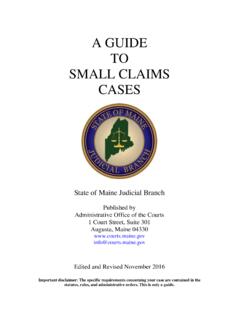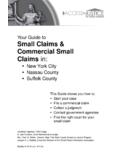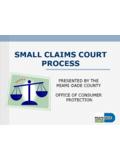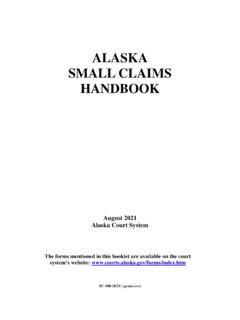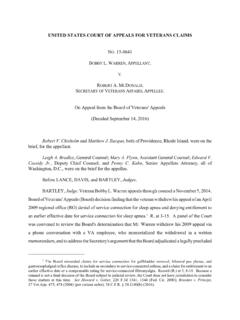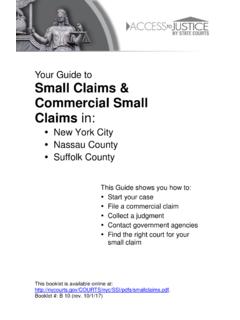Transcription of N161A Guidance notes on completing form N161 – …
1 N161A - Guidance notes on completing the appellant s notice ( ) Crown copyright 2017 Guidance notes on completing form n161 Appellant s notice (all appeals except small claims track appeals or appeals to the Family Division of the High court )Please note form n161 is to be used for fast track and multi-track cases and statutory appeals from tribunals and other outside bodies only. Appeals in small claims track cases should use form N164 Appellant s notice (small claims track only). Appeals to the Family Division of the High court should use form FP161 Appellant s notice (Appeals to the Family Division of the High court ).A free leaflet EX340 I want to appeal giving information about making an appeal in or to the High court or the County court is available from: any County court hearing centre, ; or the Clerk of the lists General Office/Appeals Office atthe Royal Courts of Justice, Strand, London WC2A leaflet will also explain the meaning of some of the terms and expressions used in this is available about making an appeal to the court of Appeal, from the Civil Appeals Office Registry, Room E308, Royal Courts of Justice, Strand, London WC2A 2LL, or on the court s website ( ).
2 court staff can help you complete the appellant's notice and tell you about procedure, they cannot give legal advice - for example, whether you should appeal or whether your appeal will be successful. If you need legal advice about bringing your appeal, you should contact a legal representative or a Citizens Advice immediately. If you are legally represented, your legal representative should complete this form on your time limits for issuing (filing) your have only a limited time in which to file your appellant s notice at the appeal court , so you must act leaflet EX340 I want to appeal will tell you which is the appropriate appeal court in your must file your appellant s notice:- within the time limit set by the judge whose order you are appealing against; or3 where that judge set no time limit, within 21 days after the date of the decision you wish to appeal against was limits which apply in the court of Appeal in specific types of appealThere are several different time limits which apply in the court of Appeal, the shortest of which is 7 days.
3 Form 207 gives details of the time limits for filing an appellant s notice in the court of Appeal. You can get a copy of the form from you need more time than is allowed for filing your appellant s notice, you must apply for an extension of time in the notice itself. (See notes to Section 10 on page 11).General notes on completing the noticeSet out below are notes to help you fill in the form. You should read the notes to each section carefully before you begin to complete that particular a separate sheet if you need more space for your answers, marking clearly which section the information refers to. Write the claim or case number on it and attach it securely to the you do not have all the documents or information you need for your appeal, you must not allow this to delay sending or taking the form to the appeal court within the correct time.
4 Complete the form as fully as possible and provide what documents you have. The notes to Section 12 will explain more about what documents you need to file with the appellant s notice (see pages 12-13).Section 1: Details of the claim or case you are appealing againstGive the claim or case number you wish to appeal against. You are required to provide the full name of all parties and to indicate whether they were the claimant, applicant or petitioner, defendant or respondent by ticking the appropriate box. You can find this and other information in the order or decision you are appealing your (appellant s) full name, and the address to which you would like all documents relating to the appeal to be sent. Include contact information, including telephone and email address if you have will also need to include the above details for the respondent to enable the court to send correspondence and other details to the respondent.
5 A respondent is a person who was a party to the proceedings in the lower court and who is affected by the appeal you are making. If there is more than one respondent, list their names, addresses and contact details 5on a separate sheet of paper and tick the details of additional parties box to indicate that you have done so. Write the claim number on it and attach it securely to your 2: Details of the appealMost of the information you will need to complete this section will be found on the order or decision you are appealing the name of the court or tribunal whose order you are appealing the name of the Judge, whose decision you wish to appeal and indicate, by ticking the relevant box, the status of the the date of the decision you seek to appeal. This is usually the date at the bottom of the order or decision being 3: Legal representationConfirm whether you are legally represented and if so, give your legal representative s name and contact whether or not you are in receipt of legal whether the respondent is legally represented and, if so, provide the name and contact details of their legal 4: Permission to appealUnless the court or tribunal from which you are appealing has granted permission to appeal, you will need to apply for permission to appeal at the appeal court (unless one of the exceptions on the next page applies).
6 If you are appealing from the Upper Tribunal to the court of Appeal you must first apply to the Upper Tribunal for permission to appeal to the court of you wish to make a second appeal, you can only do so if the court of Appeal in London gives you permission. You must make your application for permission to appeal to that court . Permission for a second appeal will only be given should note that permission will only be given where the court considers that your appeal has a real prospect of success. Where your appeal is against a case management decision, the court will also consider: whether the issue is significant enough to justify the costs of an appeal; the overall effect on the case management timetable, whether the loss of the trial date is more significant than the procedural point you wish to appeal; and whether it would be more convenient to deal with your point at the do not need permission if the order you are appealing against is one of the following: a committal order; an order refusing the grant of habeas corpus.
7 A secure accommodation order under Section 25 of the Children Act 1989 or under section 119 of the Social Services and Well-being (Wales) Act court when giving permission to appeal may, exceptionally, direct that your appeal be referred to the court of Appeal if it considers that it raises an important point of principle or practice or there is some other important reason for the court of Appeal to hear it. Where the court gives this direction, it will be shown on form N460 Reasons for allowing or refusing permission to appeal (including referral to the court of Appeal (Civil Division)) and information concerning routes of appeal or N460HC Reasons for allowing or refusing permission to appeal and information concerning routes of appeal which the court will send 5: Other information required for the appealYou are required to state the name of the judge and the date of the order you wish to appeal.
8 If you are appealing only part of an order or tribunal decision, you must write out that part (or parts) of the order in the box 6 and 7: Grounds of appeal and arguments in supportAn appeal must be based on relevant grounds (reasons for appealing). An appeal court will only allow an appeal against a decision that was either: wrong; or unjust because of a serious procedural or other irregularity in the lower court appeal court will be unlikely to overturn a decision where no real difference would be made to the outcome of the case; or the appeal would involve re-examining the factual investigation undertaken by the lower out briefly and on a separate sheet your reasons why you think the judge s decision was wrong or unjust. If possible, list your reasons in short separately numbered paragraphs and indicate you have done this by ticking the relevant that you must not include any grounds for appealing which rely on new evidence, that is evidence that has become available since the order was made.
9 You may not produce new evidence in your appeal without first obtaining the permission of the appeal court . You can apply for permission to rely on fresh evidence in the appellant s notice (see the notes to Section 10 on page 11). You will need to give reasons, however, why the new evidence was not before the original separate skeleton argument should be filed and served on the respondent(s) with your completed notice if you are appealing to the court of Appeal. If you are appealing to the County or High court , the separate skeleton argument, if required, should be filed and served on the respondent(s) with your completed notice or, if you are unable to complete your skeleton argument in time, no later than 14 days after filing your notice. Please indicate by ticking the relevant box whether you are attaching the skeleton argument to the appellant s notice or whether you intend to send it separately within 14 days of filing the appellant s notice with the arguments should contain a numbered list of points that you intend to argue at the hearing.
10 Each point should be stated in no more than a few sentences. Refer at each point to any documents you are filing with your appellant s notice which supports that argument (see Section 12 on documents).10 Other useful informationTry to consider what other information the appeal court might find useful. For example, the court may find it helpful to have a list of people who feature in the case, an explanation of technical terms used in the papers, or a list of events in date order (a chronology). If you are providing any of these, they should be on a separate piece of paper attached to your notice marked with the case or claim number and names of the 8: Aarthus Convention Claims (applications made under the Town and Contry Planning Act 1990 or Planning (Listed Buildings and Convservation Areas) Act 1990 The Aarhus Convention grants the public rights regarding access to information, public particiaption and access to justice, in government decision-making processes on matters concerning local, national and transboundary environment.)










